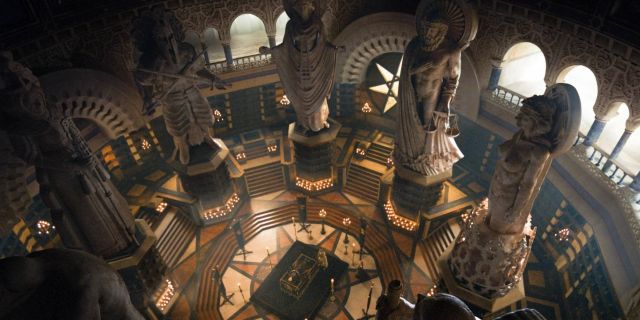Game of Thrones features a thrilling system of religion and magic. The dominant religion in Westeros is the Faith of the Seven. While some systems of worship grant their followers superpowers or life after death, the Faith of the Seven resembles modern spirituality. Despite its place of power in the Seven Kingdoms, the Faith of the Seven seems more based on tradition than theology. Its seven-faced deity has a lot to offer to the devout.
Much of Game of Thrones‘ narrative features callbacks to stories from the world’s past. History exists in songs and tall tales, many of which find themselves under strict scrutiny. Faith is also a subject of debate, which constantly pulls characters in various directions. If a fan wanted to follow the religious teachings of their favorite knights and kings, they would rarely have a full picture to learn from. For example, the Seven who are One break into some easily defined faces.
The Father

The Father, or Father Above, usually appears as a large, bearded man. His facial features are strong, and his expression is stern. He usually carries a set of scales in one hand. The Father is a wise and powerful judge. He decides which of the seven heavens or seven hells a soul goes to after their demise. Followers of the Faith of the Seven pray to the Father when they seek justice for themselves or someone else. The Father also protects his children, prompting many to pray to him for defense in combat. The Father has a holiday called the Feast Day of Our Father Above. The book outlines one notable celebration in which King Aegon III Targaryen’s Hand released all prisoners from the dungeons to enact public punishments.
The Mother

The Mother, or Mother Above, is the Father’s equal and opposite. This relationship emerges in wedding ceremonies, which see the happy couple stand between the alters of the Father and Mother. The Mother represents mercy, fertility, and compassion. Followers of the Faith of the Seven pray to her to keep their loved ones safe. When a woman becomes pregnant, she and her family frequently give offerings to the Mother. Many call her the strength of women, supporting the role she is said to hold in every woman’s life. Catelyn Stark had a special relationship with the Mother, seeing her own mom in her face. She spoke this prayer while inside a sept in an unnamed village:
My lady, look down on this battle with a mother’s eyes. They are all sons, every one. Spare them if you can, and spare my own sons as well. Watch over Robb and Bran and Rickon. Would that I were with them.
The Warrior

Always armed with a sword, the Warrior may be the most straightforward face of the Seven-in-One god. He represents strength and courage in battle. Followers pray to him for the bravery to enter fights and the might to win them. Every trial by combat features prayers on either side. Particularly gifted killers are often directly compared to the Warrior. Daemon Blackfyre, for example, was said to fight like the Warrior himself. Jamie Lannister maintains that the Warrior has been his god since he first lifted a sword, eschewing the Father’s vision of family life. Young men typically love the Warrior.
The Smith

This deity usually appears holding a hammer, but he goes by many names. Every respectable profession sees themselves in the Smith. He’s called the Farmer, the Fisherman, the Carpenter, the Cobbler, and many more. Followers believe the Smith gave humanity horses and iron to help them survive. Anyone who has a long day of labor ahead of them prays to the Smith. Many priests see honest work as a form of prayer to the Smith. King Baelor the Blessed once elevated an illiterate stonemason to the highest office in the Faith of the Seven because the King believed his work was divinely inspired.
The Maiden

This young, beautiful face represents innocence and religious chastity. The Maiden, or Maid, usually appears holding flowers. She specifically guards young ladies in dangerous situations. She also polices their behavior and demands they maintain their purity. Mothers often pray to the Maiden to keep their daughters safe. Some apologize to the Maiden after using sex as a tool to manipulate others. She also seems to oversee the “true love” aspect of marriage, while the Mother and Father monitor the dutiful elements of the arrangement.
The Crone

As an elderly woman, the Crone represents the wisdom of age. She’s likely the least-represented face of the Seven-in-One god. Her story is left quiet in most places. The Crone carries a lantern said to guide those who are lost. Her followers named a constellation after her lantern. She seems to have a unique sense of foreknowledge on some matters. She also brought the world the first raven after peering through the “door of death.” This suggests that she created the main method of communication for the people of Westeros.
The Stranger

The Seven-in-One god’s final face is their most mysterious. The Stranger is made of paradoxes. It’s male and female, but uses he/him pronouns. He doesn’t look human in the traditional sense. Some carvings make him look like an animal, while others cover his face. The Stranger is the god of death, charged with guiding the recently deceased away from the land of the living. Followers rarely pray to the Stranger, but some outcasts find solace in the idea of the outsider. His presence is necessary but widely feared. The Faceless Men worship the Stranger as an aspect of their Many-Faced God.
The Seven who are One represent any aspect of life. Their spread demonstrates the concerns of the average worshiper. Judgment, mercy, strength, hard work, innocence, guidance, and the peace that follows are the central thoughts of any person in Westeros. Game of Thrones depicts a compelling pantheon, all under the faces of one god.











Leave a Reply